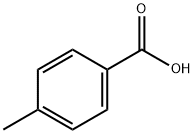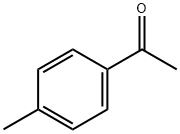
p-Toluic acid
- Product Namep-Toluic acid
- CAS99-94-5
- CBNumberCB7854776
- MFC8H8O2
- MW136.15
- EINECS202-803-3
- MDL NumberMFCD00002565
- MOL File99-94-5.mol
- MSDS FileSDS
Chemical Properties
| Melting point | 177-180 °C (lit.) |
| Boiling point | 274-275 °C (lit.) |
| Density | 1,06 g/cm3 |
| bulk density | 700kg/m3 |
| vapor pressure | 0.02 hPa (70 °C) |
| refractive index | 1.5120 (estimate) |
| Flash point | 181°C |
| storage temp. | Store below +30°C. |
| solubility | 0.3g/l |
| pka | 4.36(at 25℃) |
| form | Powder |
| color | White to slightly yellow-cream |
| PH | 3.73(1 mM solution);3.2(10 mM solution);2.69(100 mM solution) |
| Water Solubility | <0.1 g/100 mL at 19 ºC |
| Merck | 14,9535 |
| BRN | 507600 |
| Stability | Stable. Incompatible with strong oxidizing agents, strong bases. |
| InChIKey | LPNBBFKOUUSUDB-UHFFFAOYSA-N |
Safety
| Symbol(GHS) |

|
|||||||||
| Signal word | Warning | |||||||||
| Hazard statements | H317 | |||||||||
| Precautionary statements | P261-P272-P280-P302+P352-P333+P313-P362+P364 | |||||||||
| Hazard Codes | Xn | |||||||||
| Risk Statements | 22 | |||||||||
| Safety Statements | 22-24/25 | |||||||||
| WGK Germany | 1 | |||||||||
| RTECS | XU1575000 | |||||||||
| Autoignition Temperature | 570 °C | |||||||||
| TSCA | Yes | |||||||||
| HS Code | 29163900 | |||||||||
| Toxicity | LD50 orally in Rabbit: 400 mg/kg | |||||||||
| NFPA 704: |
|



